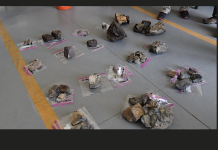
NEW YORK, Jan. 14 (UPI) — The largest dinosaur skeleton ever on display was unveiled Thursday as the star of an exhibit at New York’s American Museum of Natural History.
A newly-discovered dinosaur, 122 feet in length and nearly 20 feet tall, will be the star of an exhibit, to be unveiled Friday, at New York’s American Museum of Natural History.
Called “Titanosaur” because an official scientific name has not yet been assigned, it is among the largest dinosaurs ever discovered, so large the fourth-floor museum space cannot handle the cast-model skeleton accompanying the bones.
In life, the dinosaur would have been 122 feet in length and nearly 20 feet tall. The exhibit includes an 8-foot thigh bone among 200 others found in 2014 in southern Argentina. The head of the so-called titanosaur will be pointed at the elevators, greeting visitors with a toothy smile as they arrive.
This dinosaur, a vegetarian which largely ate the foliage of trees, weighed about 77 tons, what the museum calls the equivalent of 15 African elephants, when it stomped around Argentina’s Patagonia region, 95 million years ago. Its bones were found in a desert 135 miles west of Trelew, Argentina, after a local man made a telephone call suggesting he may have discovered a fossil.
“Everything was extremely large,” said paleontologist Diego Pol on the team which excavated the find. “After a few days working, we realized it was huge.”
“The first visit was exciting when we discovered the femur,” said paleontologist Jose Luis Carballido, a reference to the massive thigh bone, “but it was the second or third visit that we really knew the importance of the discovery.”
The exhibit will become part of the museum’s permanent display.






